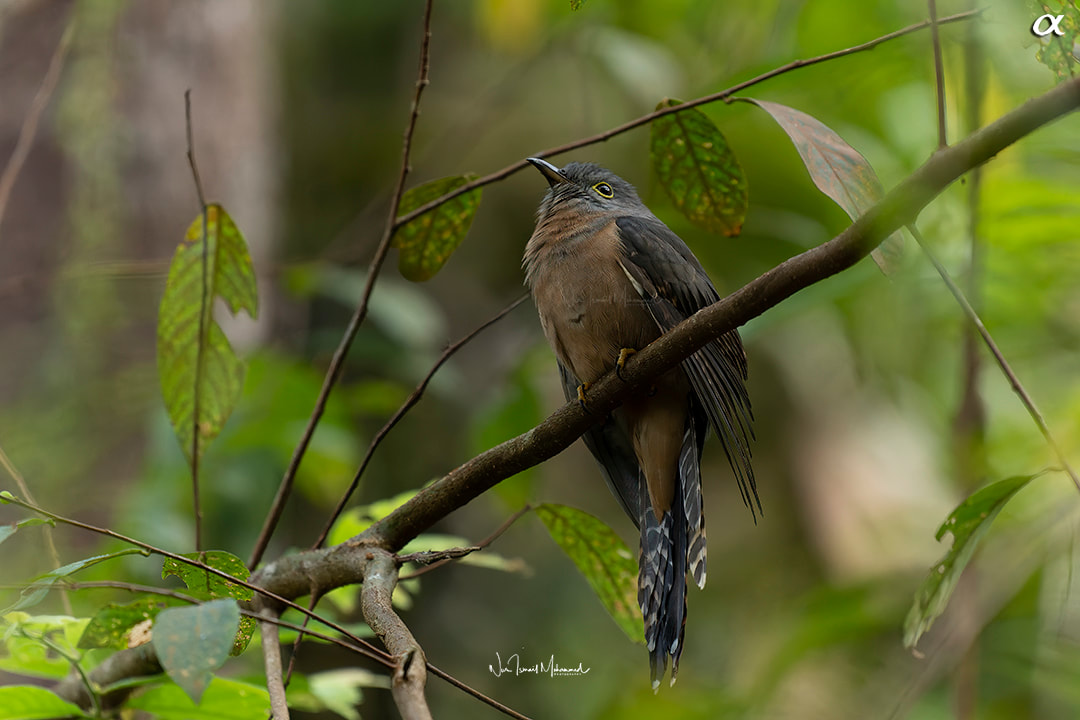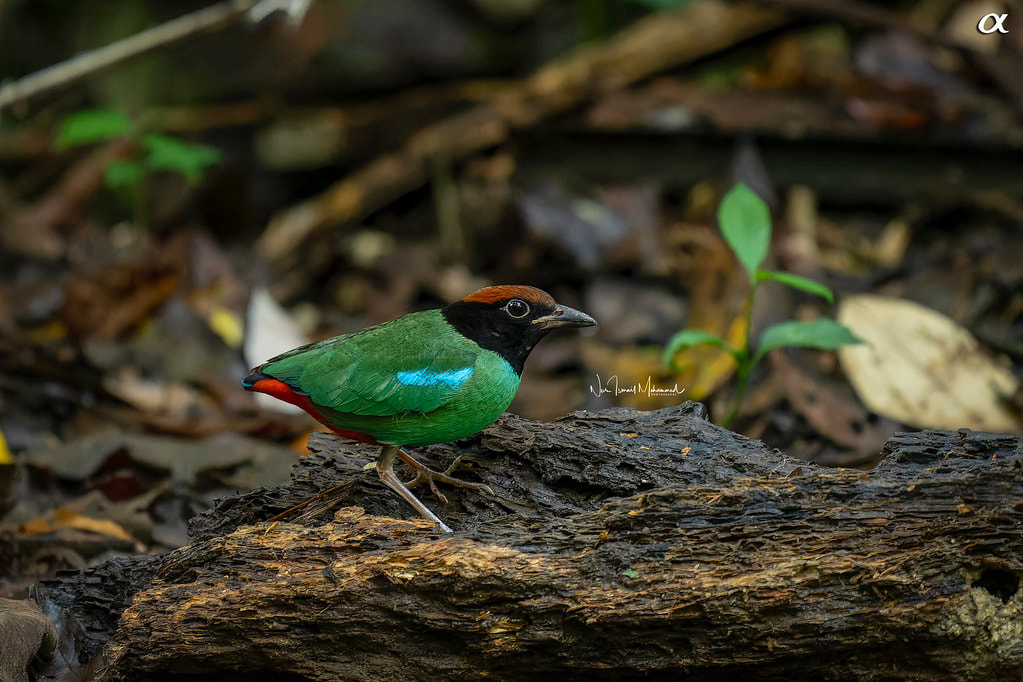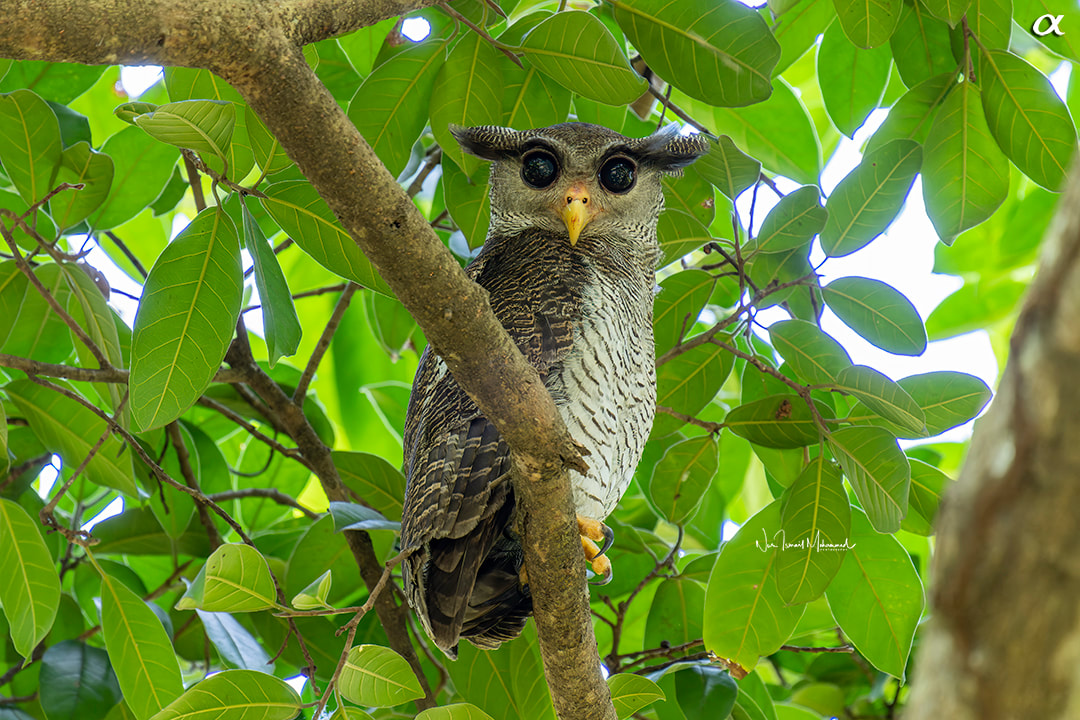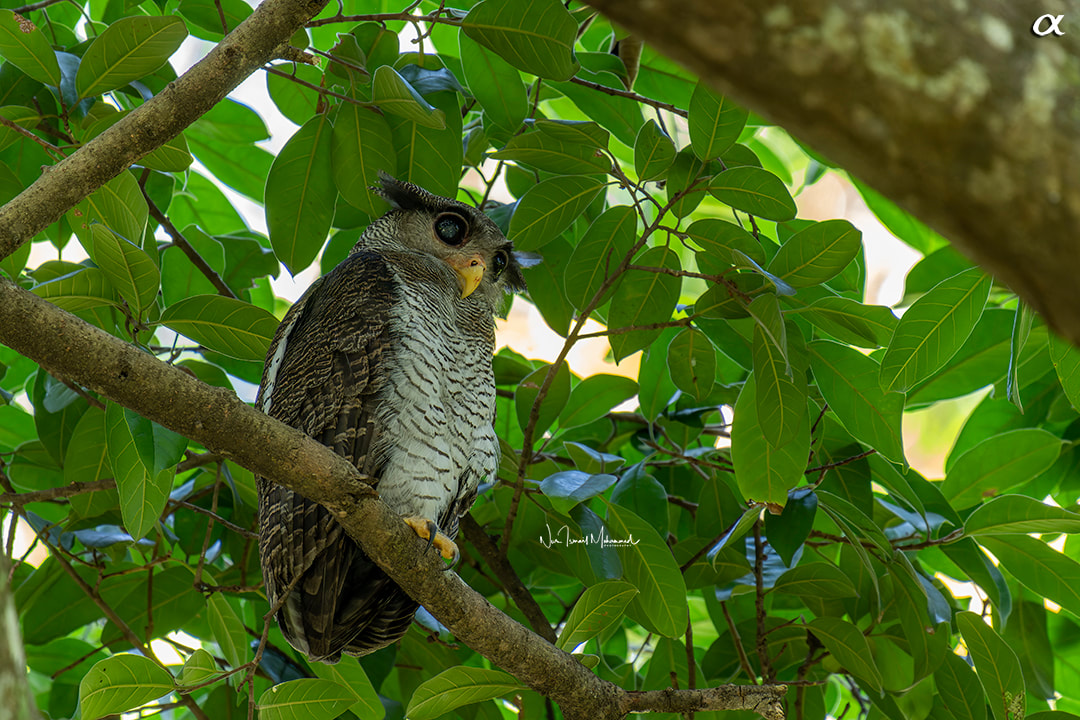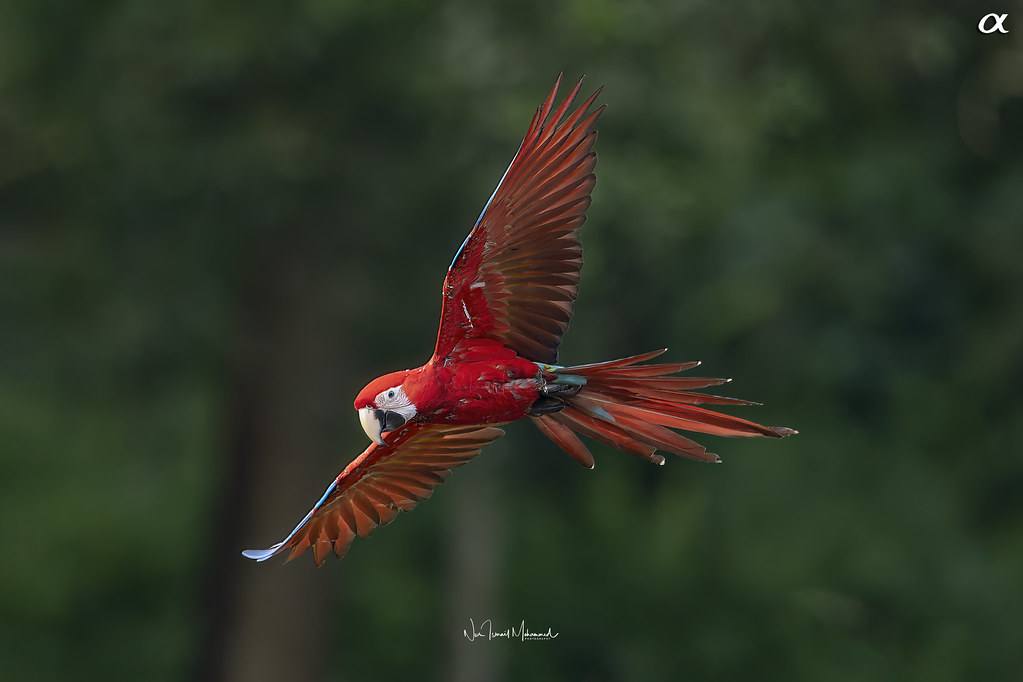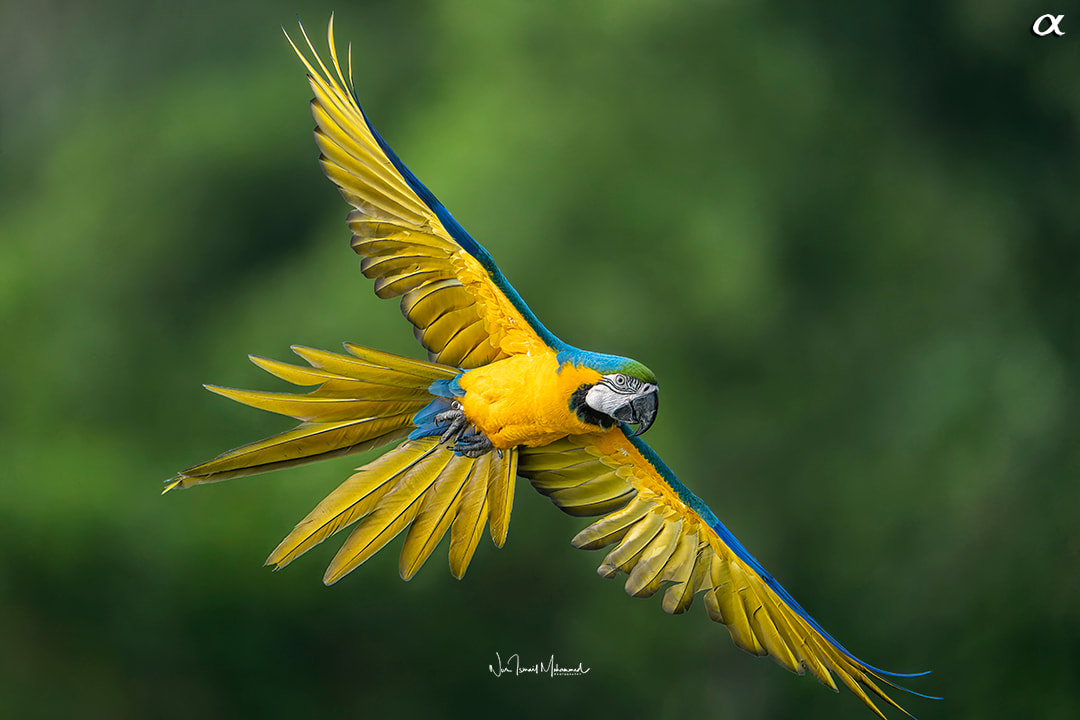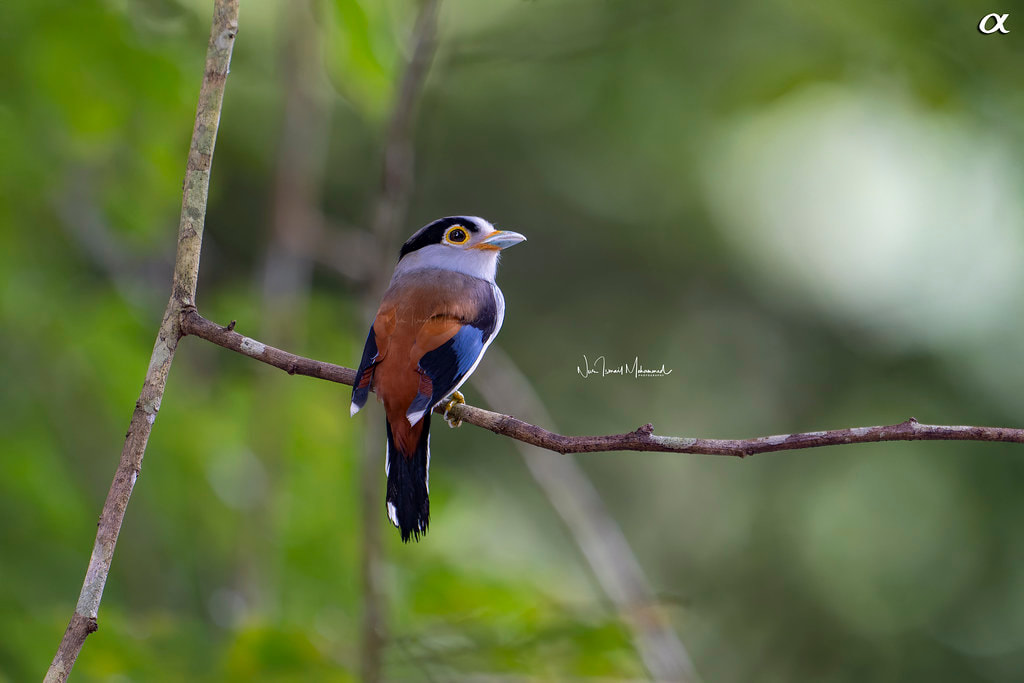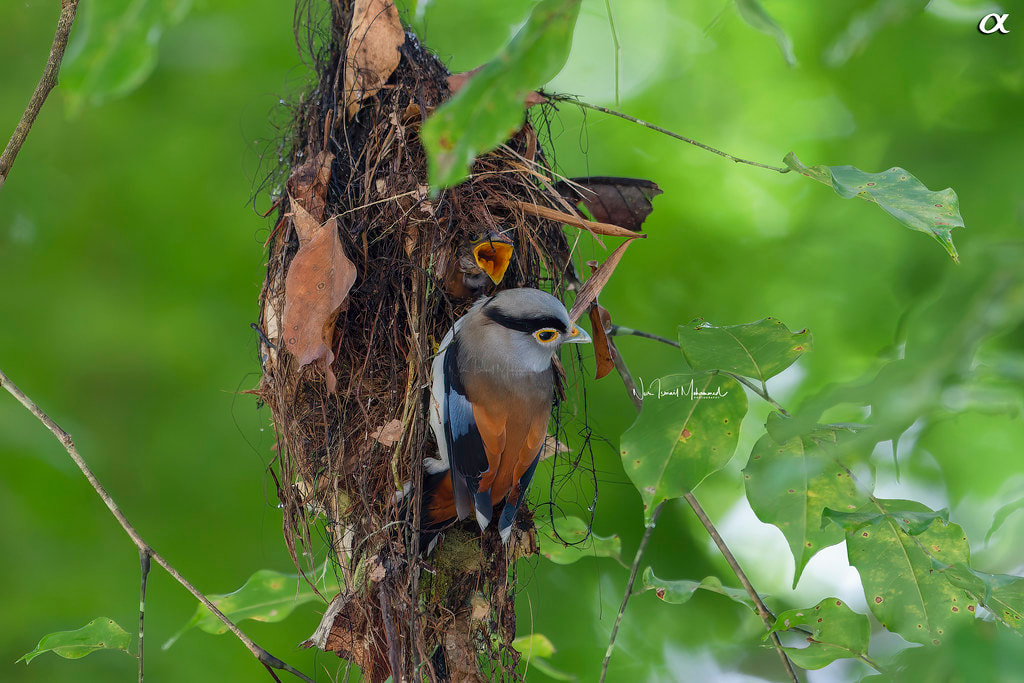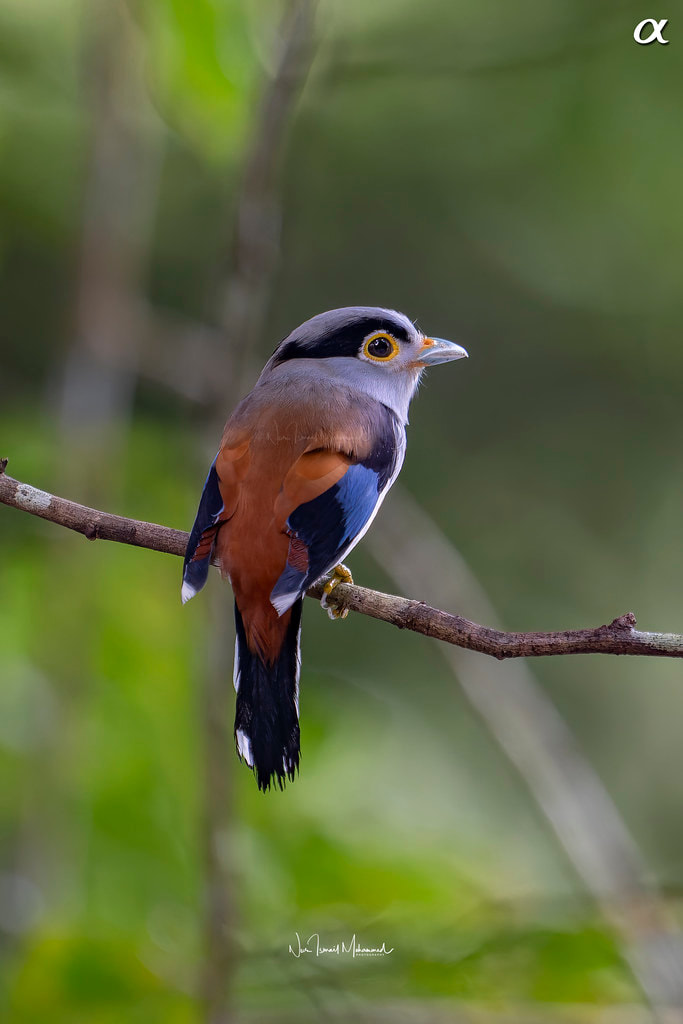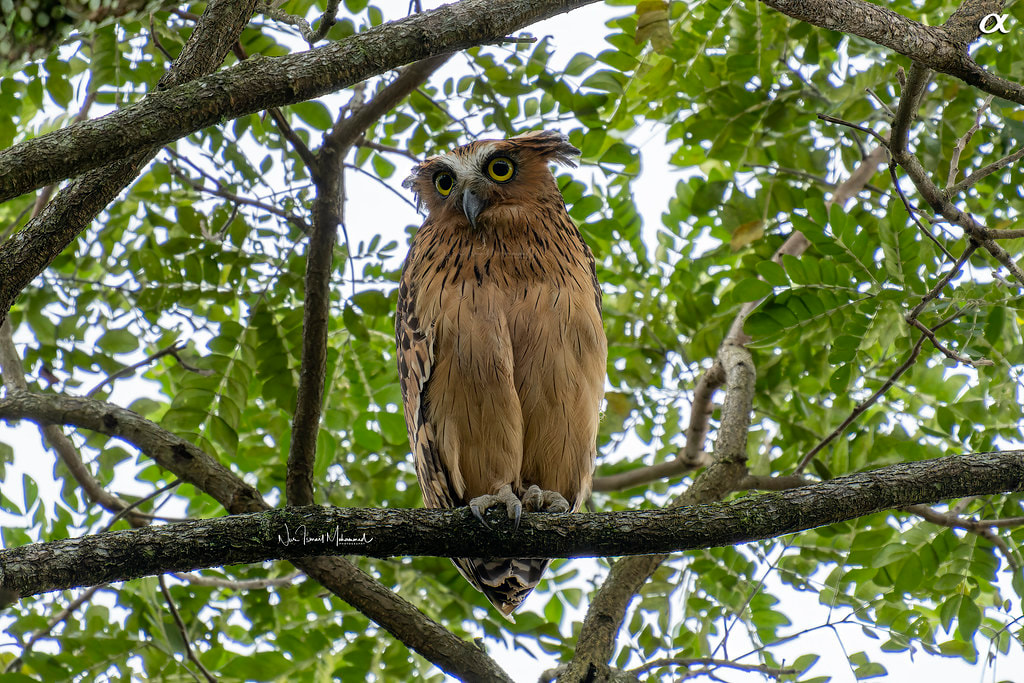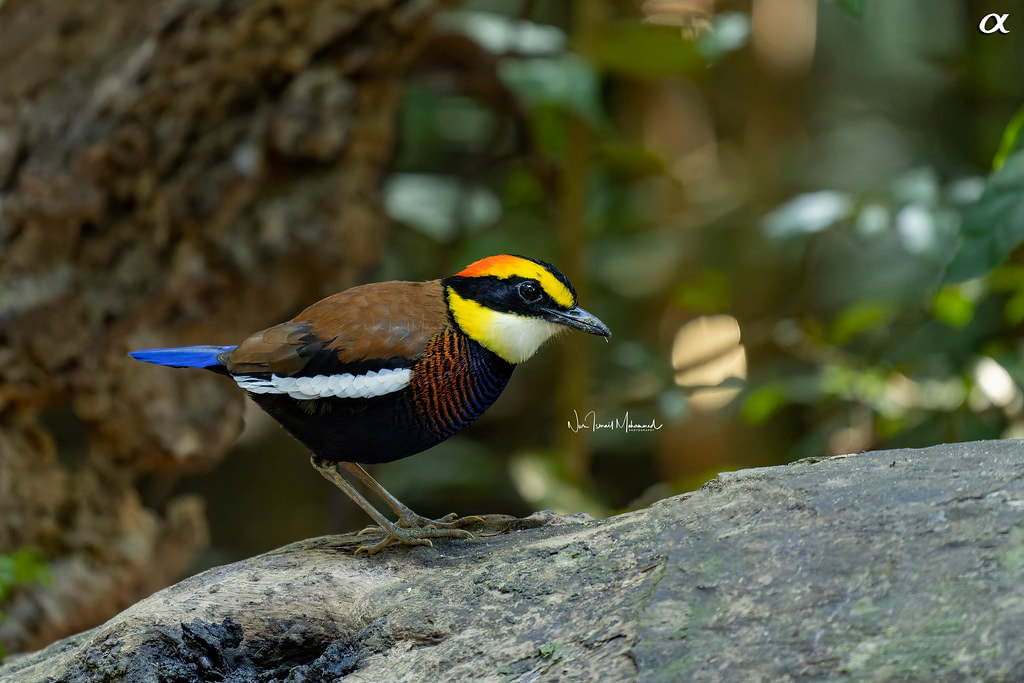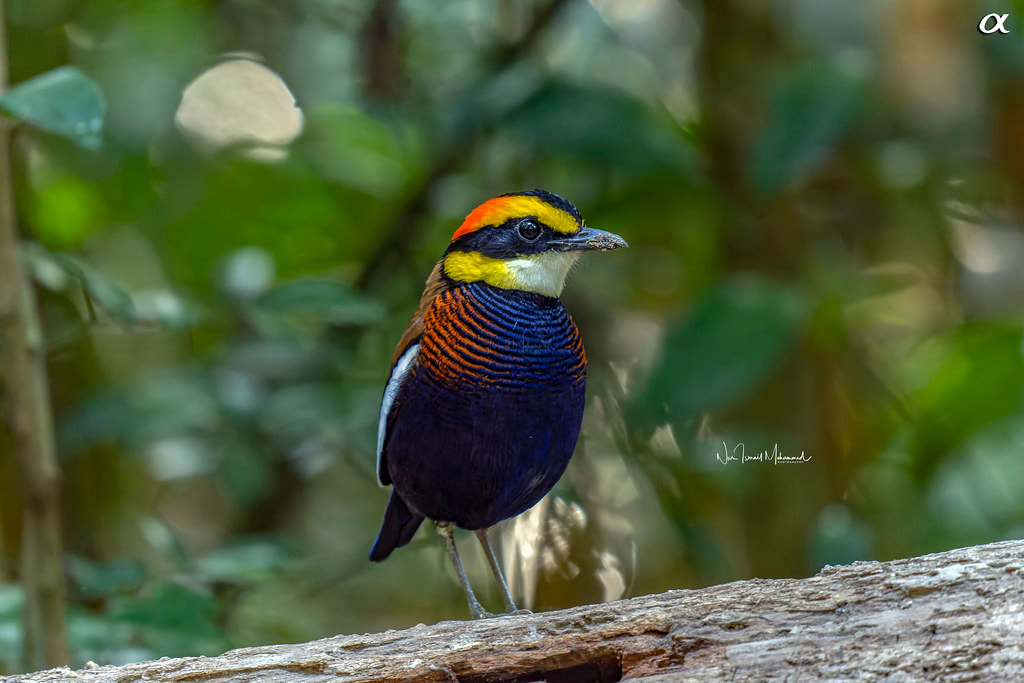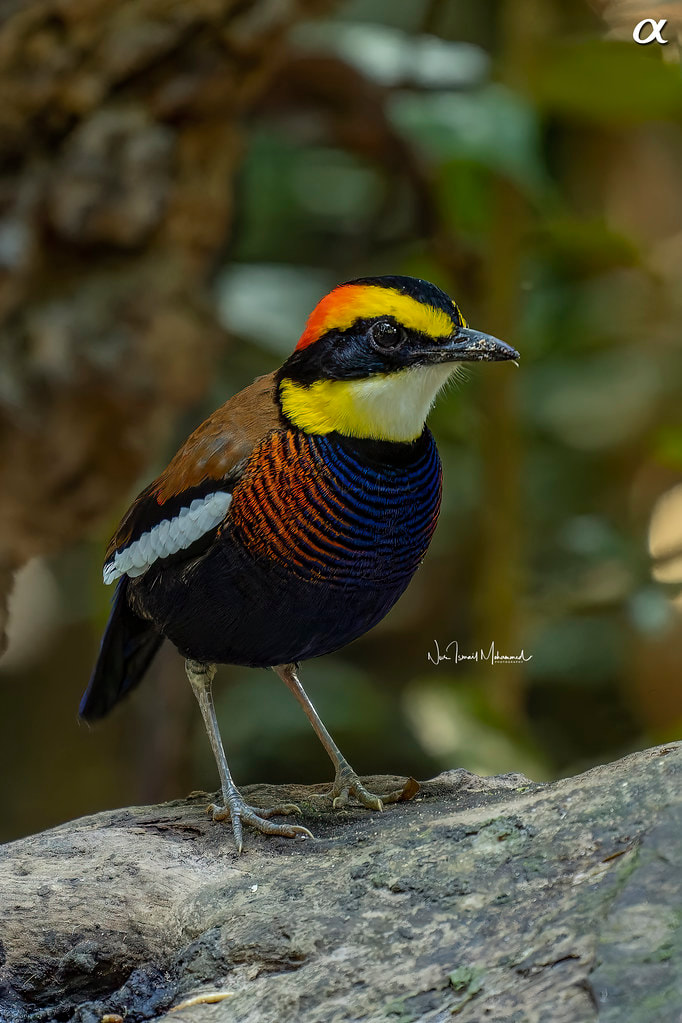|
Alcedo meninting or Blue-ear Kingfisher is a small bird that resembles the Common Kingfisher but has a much deeper blue plumage and blue ear coverts. It can be found in lowland forest up to 900 m above sea level. The main habitat requirements for kingfishers are food and nest site availability. They usually perch on branches overhanging densely shaded streams before diving below to capture prey that includes crustaceans, dragonfly larvae and fish. The adult female for Blue-ear Kingfisher is similar to the male but tend to have more rufous orange on the sides of the head and have a red lower mandible. Still, the brilliant iridescent blue line down back to its rump is best seen in flight. [Source: MyBIS] Name: Blue-eared kingfisher (female) Scientific: Alcedo meninting Malay: Pekaka Bintik-bintik Family: Alcedinidae IUCN Red List (v3.1, 2016): Least Concern Gear: SONY α1 + SEL600F40GM Location: Hulu Kelang, Selangor. #NurIsmailPhotography #sony #sonymalaysia #a1 #α1 #SEL200600G #alpha #AlphaGuru #SAG #DXO #PureRAW #topazlabs #leofoto #pg1 #Fight4ourPlanet #DiscoverWithMYAlpha #DiscoverWithAlpha #AlphaUniverseMY #FullFrameLife #MySONYLife
Copyright © 2022 Nur Ismail Photography. All rights reserved. Do not use or reproduce these images on websites, blogs or publications without expressed written permission from the photographer. For any enquiries, please visit my website: www.nurismailphotography.com or email at nismailm@gmail.com. Flickr: www.flickr.com/photos/nurismailphotography/
0 Comments
The rusty-breasted cuckoo is a species of cuckoo in the family Cuculidae. It is found in Indonesia, Malaysia, the Philippines, Singapore, and Thailand. Its natural habitat is subtropical or tropical moist lowland forests. It is sometimes considered a subspecies of the brush cuckoo. [Source: Wikipedia] Name: Rusty-breasted cuckoo (male) Scientific: Cacomantis sepulcralis Malay: Sewah Dada Jingga / Sewah Gila / Sewah Gua Family: Cuculidae IUCN Red List (v.3.1, 2016): Least concern Gear: SONY α1 + SEL200600G Location: Taiping, Perak #NurIsmailPhotography #sony #sonymalaysia #a1 #α1 #SEL200600G #alpha #AlphaGuru #SAG #DXO #PureRAW #topazlabs #leofoto #pg1 #Fight4ourPlanet #DiscoverWithMYAlpha #DiscoverWithAlpha #AlphaUniverseMY #FullFrameLife #MySONYLife
Copyright © 2022 Nur Ismail Photography. All rights reserved. Do not use or reproduce these images on websites, blogs or publications without expressed written permission from the photographer. For any enquiries, please visit my website: www.nurismailphotography.com or email at nismailm@gmail.com. Flickr: www.flickr.com/photos/nurismailphotography/ Hooded Pitta (Pitta sordida) is a species of bird belonging to the family Pittidae. It is a small bird measuring around 16–19 cm. It has a black hood with brown crown and in contrast, it has a bright green mantle, breast, and upper belly. It also has a red lower belly and under tail coverts. The population distribute throughout the Oriental region, Australasia, which encompasses Myanmar and southern China through Southeast Asia and the Malay Peninsula. This bird is an uncommon passage migrant and winter visitor, south to Singapore. It forages on the forest floor and feeds on worms, insects, and other invertebrates. The population has declined rapidly due to habitat destruction and cage bird trade (IUCN, 2016). [Source: MyBIS] Name: Hooded pitta Scientific: Pitta sordida Malay: Burung Pacat Hijau / Berlau Bertudung / Pacat Gembala Pelanduk / Burung Pita Hijau Family: Pittidae IUCN Red List (v3.1, 2016): Least Concern Gear: SONY α1 + SEL200600G Location: Taiping, Perak #NurIsmailPhotography #sony #sonymalaysia #a1 #SEL200600G #alpha #AlphaGuru #SAG #DXO #PureRAW #topazlabs #leofoto #pg1 #Fight4ourPlanet #DiscoverWithMYAlpha #DiscoverWithAlpha #AlphaUniverseMY #FullFrameLife #MySONYLife
Copyright © 2022 Nur Ismail Photography. All rights reserved. Do not use or reproduce these images on websites, blogs or publications without expressed written permission from the photographer. For any enquiries, please visit my website: www.nurismailphotography.com or email at nismailm@gmail.com. Flickr: www.flickr.com/photos/nurismailphotography/ Bubulcus ibis is noticeably small and compact compared to other herons. This species can be found especially near the marshes, pools, rice fields, and grasslands (Strange & Jeyarajasingam, 1993). It gains its common name, Cattle Egret from its habit of commonly wandering alongside herds of cattle. The Cattle Egret feeds mainly on a variety of insects, spiders, frogs and worms. It has medium length, broad and rounded wings and slightly different colour patterns between juvenile, adult and during breeding seasons. The juveniles have dark legs and bill whereas the adults are all white with yellow bill and greyish-yellow legs. During breeding season, the Cattle Egret has golden plumage on their head, chest, and back. [Source: MyBIS] Name: Cattle egret (breeding plumage) Scientific: Bubulcus ibis Malay: Bangau Balau / Bangau Kendi / Bangau Kerbau Family: Ardeidae IUCN Red List (v3.1, 2016): Least Concern Gear: SONY α1 + SEL600F40GM Location: Taman Tasik Permaisuri, Kuala Lumpur #NurIsmailPhotography #sony #sonymalaysia #a1 #α1 #SEL600F40GM #alpha #AlphaGuru #SAG #DXO #PureRAW2 #topazlabs #leofoto #pg1 #Fight4ourPlanet #DiscoverWithMYAlpha #DiscoverWithAlpha #AlphaUniverseMY #FullFrameLife #MySONYLife
Copyright © 2022 Nur Ismail Photography. All rights reserved. Do not use or reproduce these images on websites, blogs or publications without expressed written permission from the photographer. For any enquiries, please visit my website: www.nurismailphotography.com or email at nismailm@gmail.com. Flickr: www.flickr.com/photos/nurismailphotography/ Bubo sumatranus or commonly known as the Barred Eagle-owl or the Malaya Eagle Owl is a large and stocky build measuring around 48 cm in length (Strange & Jeyarajasingam, 1993). It belongs to the Strigidae family. This owl is fairly common in Malaysia and throughout much of South-East Asia. It can be found in logged and unlogged forest in lowlands, seldom far up in hilly land and sometimes near rural villages. The barred eagle-owl appears with grey-brown upperparts, crossed and mottled with several zigzag bars of rufous-tawny colour, being broadest on the back. The upper-tail is dark brown with about six whitish or tawny bars. It also has brown eyes and a yellowish bill set in a pale face-mask; narrow black barring on otherwise whitish underparts, becoming brown on breast and mottled brown above and on its crown. The juvenile is pure white and becomes dirty white in the transition to adult plumage but is banded with brown on the wings and tail. The ear tufts are much shorter than on mature birds. This species can be distinguished by its barred underparts, large but sideways-slanting ear tufts, a white bar running from the eyebrows through the front of the ear tufts and much more heavily marked upper breast than the lower breast. It has a very broad and opportunistic diet, feeding on large insects like grasshopper and beetles, birds, small mammals especially rodents including mice and rats, and reptiles, largely snakes. [Source: MyBIS] Name: Barred eagle owl Scientific: Bubo sumatranus Malay: Burung Hantu Bubu / Burung Hantu Jalur / Hantu Bubu Family: Strigidae IUCN Red List (v3.1, 2016): Least Concern Gear: SONY α1 + SEL200600G + SEL14TC Location: Bukit Mertajam, Penang #NurIsmailPhotography #sony #sonymalaysia #a1 #α1 #SEL600F40GM #alpha #AlphaGuru #SAG #DXO #PureRAW2 #topazlabs #leofoto #pg1 #Fight4ourPlanet #DiscoverWithMYAlpha #DiscoverWithAlpha #AlphaUniverseMY #FullFrameLife #MySONYLife
Copyright © 2022 Nur Ismail Photography. All rights reserved. Do not use or reproduce these images on websites, blogs or publications without expressed written permission from the photographer. For any enquiries, please visit my website: www.nurismailphotography.com or email at nismailm@gmail.com. Flickr: www.flickr.com/photos/nurismailphotography/ The family Psittacidae or parrots is one of three families of true parrots. It comprises the roughly 10 species of subfamily Psittacinae (the Old World or Afrotropical parrots) and 157 of subfamily Arinae (the New World or Neotropical parrots), as well as several species that have gone extinct in recent centuries. Some of the most iconic birds in the world are represented here, such as the blue-and-gold macaw among the New World parrots and the grey parrot among the Old World parrots. All of the parrot species in this family are found in tropical and subtropical zones and inhabit Mexico, Central and South America, the Caribbean islands, sub-Saharan Africa, the island of Madagascar, the Arabian Peninsula, Southeast Asia, Australia and Oceania. Two parrots, one extinct and the other extirpated, formerly inhabited North America. [Source: Wikipedia & MyBIS] Last weekend I was invited by a friend, on short notice) to visit the Free Fly Parrot Malaysia (FFPM) outing at Bukit Antarabangsa near Kuala Lumpur. There were at least 40 parrot enthusiasts present at the event, with numerous species of parrots, among other Blue-and-yellow macaw, Scarlet macaw, Red-and-green macaw, to name a few. I was glad that I have my SONY a1 with the SONY FE 600 F4 GM OSS lens (on loan) to put it to test and sharpen my bird-in-flight skill. Look forward to the next FFPM's outing! #NurIsmailPhotography #sony #sonymalaysia #a1 #α1 #SEL600F40GM #alpha #AlphaGuru #SAG #DXO #PureRAW2 #topazlabs #leofoto #pg1 #Fight4ourPlanet #DiscoverWithMYAlpha #DiscoverWithAlpha #AlphaUniverseMY #FullFrameLife #MySONYLife
Copyright © 2022 Nur Ismail Photography. All rights reserved. Do not use or reproduce these images on websites, blogs or publications without expressed written permission from the photographer. For any enquiries, please visit my website: www.nurismailphotography.com or email at nismailm@gmail.com. Flickr: www.flickr.com/photos/nurismailphotography/ Serilophus lunatus is a bird species from the broadbill family that is commonly known as Silver-breasted broadbill. This medium-sized bird measures about 16-17 cm in length and like to consume invertebrates, primarily insects such as grasshoppers, mantises, caterpillars, larvae and small land snails. It is found in the montane forest up to about 800-1,600 m, in the middle storey and forest edges. The Silver-breasted broadbill is monotypic as it is the only species within the genus Serilophus. It has a rusty-coloured head with an ash-grey forehead and a broad black supercilium (stripe) over its eyes. It also has white underpart, brilliant blue and yellow bill, black tail, bright rufous at the rump and upper wing coverts; and striking blue and black flight feathers. The female's appearance is similar to the male but with a narrow silvery white band across its breast, while the juvenile is slightly different and has shorter wings and tails with slightly darker plumage overall. [Source: MyBIS] Recently, I was privileged to come across a nesting Silver-breasted broadbill in Hulu Langat, Selangor. Had the opportunity to visit during nest building stage and eventually the day before the chicks fledged. Here are some of the images taken with SONY a1 and SONY FE 600mm F/4 GM OSS (loan unit). Hope to come across future nesting of this beautiful bird. Name: Silver-breasted broadbill (female) Scientific: Serilophus lunatus Malay: Burung Tadah Hujan / Takau Dada-perak / Takau Tanda Hujan Family: Eurylaimidae IUCN Red List (v3.1, 2016): Least Concern Gear: SONY α1 + SEL600F40GM Location: Hulu Langat, Selangor #NurIsmailPhotography #sony #sonymalaysia #a1 #SEL600F40GM #alpha #AlphaGuru #SAG #DXO #PureRAW2 #topazlabs #leofoto #pg1 #Fight4ourPlanet #DiscoverWithMYAlpha #DiscoverWithAlpha #AlphaUniverseMY #FullFrameLife #MySONYLife
Copyright © 2022 Nur Ismail Photography. All rights reserved. Do not use or reproduce these images on websites, blogs or publications without expressed written permission from the photographer. For any enquiries, please visit my website: www.nurismailphotography.com or email at nismailm@gmail.com. Flickr: www.flickr.com/photos/nurismailphotography/ Both local name and scientific name of the mad-looking owl, Ketupa ketupu are based on the wild, ululating four-note call. Commonly, Ketupa ketupu can be found in the forested area near waters. It’s also found in mangrove forest and other coastal areas with woods and bushes (Jeyarajasingam, 2012). Ketupa ketupu has a rich brown colour on the upperparts while the underparts are rufous-buff or fulvous with narrow dark brown shaft-streaks. It also has large ear tufts, and yellow eyes with the eyelids rimmed black. As for the food, a large proportion of the Buffy Fish Owl's diet consists of fish, as well as crustaceans, reptiles, frogs, toads and insects. Rats, mice and large beetles are also eaten. [Source: MyBIS] Had a short opportunity with my buddy Hairol Mat Zin to photograph this owl during my trip to Seri Iskandar for my daughter's graduation last December 2021. The owl was quite far away that I had to use the teleconverter to get closer images, and the backlight is also not helping. Have a nice day! Name: Malay buffy fish owl Scientific: Ketupa ketupu Malay: Hantu Kuning / Ketuk Ketampi / Ketumpok Ketampi / Tumbuk Ketampi Family: Strigidae IUCN Red List (v3.1, 2016): Least Concern Gear: SONY α1 + SEL200600G + SEL14TC Location: Batu Gajah, Perak #NurIsmailPhotography #sony #sonymalaysia #a1 #SEL200600G #SEL14TC #alpha #AlphaGuru #SAG #DXO #PureRAW #topazlabs #leofoto #pg1 #Fight4ourPlanet #DiscoverWithMYAlpha #DiscoverWithAlpha #AlphaUniverseMY #FullFrameLife #MySONYLife
Copyright © 2022 Nur Ismail Photography. All rights reserved. Do not use or reproduce these images on websites, blogs or publications without expressed written permission from the photographer. For any enquiries, please visit my website: www.nurismailphotography.com or email at nismailm@gmail.com Flickr: www.flickr.com/photos/nurismailphotography/ Banded pitta, scientifically known as Hydrornis irena is belongs to the family Pittidae. It can grow up to 23 cm. Both sexes have a clearly visible broad yellow supercilium which grades into the deep orange on the nape. They are also have a black central crown stripe, broad eye lines, a golden brown mantle, deep blue tail, white streaks on its wings and throat with a yellowish tinge on the sides of its neck. To differentiate both sexes, the male entire underparts are covered by dark blue with orange bands across the breast. Meanwhile, the female entire underparts are marked with narrower buff brown and black bands. H. irena forages in the ground storeys either singly or in pairs. This species is locally common at low elevations found in the Malay Peninsula, Sumatra, Borneo, and Java. [Source: MyBis] These series of the Malayan banded pitta images was taken during my trip to Kedah in February 2022. Name: Malayan banded pitta (male) Scientific: Hydrornis irena Malay: Burung Pacat Belang Malaya / Burung Pacat Berjalur Family: Pittidae IUCN Red List (v3.1, 2016): Near Threatened Gear: SONY α1 + SEL200600G Lokasi: Kedah #NurIsmailPhotography #sony #sonymalaysia #a1 #α1 #SEL200600G #alpha #AlphaGuru #SAG #DXO #PureRAW2 #topazlabs #leofoto #pg1 #Fight4ourPlanet #DiscoverWithMYAlpha #DiscoverWithAlpha #AlphaUniverseMY #FullFrameLife #MySONYLife
Copyright © 2022 Nur Ismail Photography. All rights reserved. Do not use or reproduce these images on websites, blogs or publications without expressed written permission from the photographer. For any enquiries, please visit my website: www.nurismailphotography.com or email at nismailm@gmail.com. Flickr: www.flickr.com/photos/nurismailphotography/ Assalamualaikum & good day to all. I am truly pleased and humbled that one of my photos was featured in SONY’s Lens Photobook 2022. My special thanks to SONY Malaysia for their endless support and look forward for more collaborations in the future. #NurIsmailPhotography #sony #sonymalaysia #a1 #α1 #SEL200600G #SEL14TC #alpha #AlphaGuru #SAG #Fight4ourPlanet #DiscoverWithMYAlpha #DiscoverWithAlpha #AlphaUniverseMY #FullFrameLife #MySONYLife
|
AuthorThis is the photography journey of Nur Ismail Photography where all the experiences from this year onwards will be shared with the audience. In collaboration with NiSi Malaysia, Leofoto, SONY Malaysia and Skylum Software. Thanks for viewing! Archives
August 2022
Categories |







